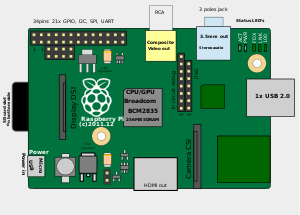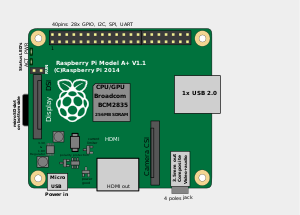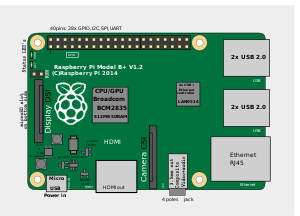RASPBERRY PI
INTRODUCTION TO PI
Raspberry Pi is a series of small single-board computers developed in the United Kingdom by the Raspberry Pi Foundation to promote the teaching of basic computer science in schools and in developing countries.The original model became far more popular than anticipated,[8] selling outside its target market for uses such as robotics. It does not include peripherals (such as keyboards, mice and cases). However, some accessories have been included in several official and unofficial bundles.[8]
The organisation behind the Raspberry Pi consists of two arms. The first two models were developed by the Raspberry Pi Foundation. After the Pi Model B was released, the Foundation set up Raspberry Pi Trading, with Eben Upton as CEO, to develop the third model, the B+. Raspberry Pi Trading is responsible for developing the technology while the Foundation is an educational charity to promote the teaching of basic computer science in schools and in developing countries.
According to the Raspberry Pi Foundation, over 5 million Raspberry Pis were sold by February 2015, making it the best-selling British computer.[9] By November 2016 they had sold 11 million units, and 12.5m by March 2017, making it the third best-selling "general purpose computer".[12] In July 2017, sales reached nearly 15 million.[13] In March 2018, sales reached 19 million.
MODELS OF THE PI:
PI ZERO
PI MODEL A
PI MODEL B
PI MODEL A+
PI MODEL B+
PI MODEL THREE
SPECIFICATIONS OF RASPBERRY PI:
| Generation | Model A | Model B | Compute module* | Zero | ||||||||||
|---|---|---|---|---|---|---|---|---|---|---|---|---|---|---|
| 1 | 1 + | 1 | 1 + | 2 | 2 ver 1.2 | 3 | 3+ | 1 | 3 | 3 lite | PCB ver 1.2 | PCB ver 1.3 | W (wireless) | |
| Release date | February 2013[50] | November 2014[51] | April–June 2012 | July 2014[52] | February 2015[22] | October 2016[53] | February 2016[24] | 14 March 2018[1] | April 2014[54][55] | January 2017[56] | November 2015[57] | May 2016 | 28 February 2017 | |
| Target price (USD) | $25[50] | $20[51] | $35[58] | $25[59] | $35 | $35 | $35 | $35 | $30 (in batches of 100)[60] | $30 | $25 | $5[57] | $5 | $10 |
| Instruction set | ARMv6Z (32-bit) | ARMv7-A (32-bit) | ARMv8-A (64/32-bit) | ARMv6Z (32-bit) | ARMv8-A (64/32-bit) | ARMv6Z (32-bit) | ||||||||
| SoC | Broadcom BCM2835[20] | BroadcomBCM2836 | Broadcom BCM2837 | Broadcom BCM2837B0[1] | BroadcomBCM2835[60] | BroadcomBCM2837 | Broadcom BCM2835 | |||||||
| FPU | VFPv2; NEON not supported | VFPv3 + NEON | VFPv4 + NEON | VFPv2; NEON not supported | VFPv4 + NEON | VFPv2; NEON not supported | ||||||||
| CPU | 1× ARM1176JZF-S 700 MHz[20] | 4× Cortex-A7900 MHz | 4× Cortex-A53900 MHz | 4× Cortex-A53 1.2 GHz | 4× Cortex-A53 1.4 GHz | 700 MHz single-core ARM1176JZF-S | 1.2 GHz 64-bit quad-core ARM Cortex-A53 | 1 GHz single-core ARM1176JZF-S[57] | ||||||
| GPU | Broadcom VideoCore IV @ 250 MHz (BCM2837: 3D part of GPU @ 300 MHz, video part of GPU @ 400 MHz)[61][62] OpenGL ES 2.0 (BCM2835, BCM2836: 24 GFLOPS / BCM2837: 28.8 GFLOPS) MPEG-2 and VC-1 (with license),[63] 1080p30 H.264/MPEG-4 AVC high-profile decoder and encoder[20] (BCM2837: 1080p60) | |||||||||||||
| Memory (SDRAM) | 256 MB (shared with GPU) | 512 MB (shared with GPU) as of 4 May 2016. Older boards had 256 MB (shared with GPU)[64] | 1 GB (shared with GPU) | 512 MB (shared with GPU) | 1 GB (shared with GPU) | 512 MB (shared with GPU) | ||||||||
| USB 2.0 ports[41] | 1 (direct from BCM2835 chip) | 2 (via on-board 3-port USB hub)[65] | 4 (via on-board 5-port USB hub)[39][52][66] | 1 (direct from BCM2835 chip) | 1 (direct from BCM2837 chip) | 1 Micro-USB (direct from BCM2835 chip) | ||||||||
| Video input | 15-pin MIPI camera interface (CSI) connector, used with the Raspberry Pi camera or Raspberry Pi NoIR camera[67] | 2× MIPI camera interface (CSI)[60][68][69] | None | MIPI camera interface (CSI)[70] | ||||||||||
| Video outputs | HDMI (rev 1.3) composite video (RCA jack), MIPI display interface (DSI) for raw LCD panels | HDMI (rev 1.3), composite video (3.5 mm TRRS jack), MIPI display interface (DSI) for raw LCDpanels | HDMI (rev 1.3), composite video (RCA jack), MIPI display interface (DSI) for raw LCDpanels | HDMI (rev 1.3), composite video (3.5 mm TRRS jack), MIPI display interface (DSI) for raw LCD panels | HDMI, 2× MIPI display interface (DSI) for raw LCDpanels,[60][69][71][72]composite video[68][73] | Mini-HDMI, 1080p60,[57]composite video via marked points on PCB for optional header pins[74] | ||||||||
| Audio inputs | As of revision 2 boards via I²S[75] | |||||||||||||
| Audio outputs | Analog via 3.5 mm phone jack; digital via HDMI and, as of revision 2 boards, I²S | Analog, HDMI, I²S | Mini-HDMI, stereo audio through PWM on GPIO | |||||||||||
| On-board storage[41] | SD, MMC, SDIO card slot (3.3 Vwith card power only) | MicroSDHCslot[52] | SD, MMC, SDIO card slot | MicroSDHC slot | MicroSDHC slot, USB Boot Mode[76] | 4 GB eMMC flash memory chip[60] | MicroSDHC | |||||||
| On-board network[41] | None[77] | 10/100 Mbit/s Ethernet (8P8C) USB adapter on the USB hub[65] | 10/100 Mbit/s Ethernet, 802.11n wireless, Bluetooth 4.1 | 10/100/1000 Mbit/s Ethernet[66] (real speed ~300 Mbit/s[citation needed]), 802.11ac dual band 2.4/5 GHz wireless, Bluetooth 4.2 LS BLE | None | 802.11n wireless, Bluetooth 4.1 | ||||||||
| Low-level peripherals | 8× GPIO[78]plus the following, which can also be used as GPIO: UART, I²Cbus, SPI bus with two chip selects, I²Saudio[79]+3.3 V, +5 V, ground[61][80] | 17× GPIOplus the same specific functions, and HAT ID bus | 8× GPIOplus the following, which can also be used as GPIO: UART, I²Cbus, SPIbus with two chip selects, I²Saudio +3.3 V, +5 V, ground.
An additional 4× GPIOare available on the P5 pad if the user is willing to make solder connections
| 17× GPIO plus the same specific functions, and HAT ID bus | 46× GPIO, some of which can be used for specific functions including I²C, SPI, UART, PCM, PWM[81] | 17× GPIO plus the same specific functions, and HAT ID bus[57] | ||||||||
| Power ratings | 300 mA (1.5 W)[82] | 200 mA (1 W)[83] | 700 mA (3.5 W) | 200 mA (1 W) average when idle, 350 mA (1.75 W) maximum under stress (monitor, keyboard and mouse connected)[4] | 220 mA (1.1 W) average when idle, 820 mA (4.1 W) maximum under stress (monitor, keyboard and mouse connected)[4] | 300 mA (1.5 W) average when idle, 1.34 A (6.7 W) maximum under stress (monitor, keyboard, mouse and WiFi connected)[4] | 459 mA (2.295 W) average when idle, 1.13 A (5.661 W) maximum under stress (monitor, keyboard, mouse and WiFi connected)[84] | 200 mA (1 W) | 700 mA (3.5 W) | 100 mA (0.5 W) average when idle, 350 mA (1.75 W) maximum under stress (monitor, keyboard and mouse connected)[4] | ||||
| Power source | 5 V via MicroUSB or GPIO header | |||||||||||||
| Size | 85.60 mm × 56.5 mm (3.370 in × 2.224 in), excluding protruding connectors | 65 mm × 56.5 mm × 10 mm (2.56 in × 2.22 in × 0.39 in), same as HAT board | 85.60 mm × 56.5 mm (3.370 in × 2.224 in), excluding protruding connectors | 85.60 mm × 56.5 mm × 17[85] mm (3.370 in × 2.224 in × 0.669 in) | 67.6 mm × 30 mm (2.66 in × 1.18 in) | 67.6 mm × 31 mm (2.66 in × 1.22 in) | 65 mm × 30 mm × 5 mm (2.56 in × 1.18 in × 0.20 in) | |||||||
| Weight | 31 g (1.1 oz) | 23 g (0.81 oz) | 45 g (1.6 oz) | 7 g (0.25 oz)[86] | 9 g (0.32 oz)[87] | |||||||||
| Console | Adding a USB network interface via tethering[77] or a serial cable with optional GPIO power connector[88] | |||||||||||||
| Generation | 1 | 1 + | 1 | 1 + | 2 | 2 ver 1.2 | 3 | 3+ | 1 | 3 | 3 lite | PCB ver 1.2 | PCB ver 1.3 | W (wireless) |
| Type | Model A | Model B | Compute Module* | Zero | ||||||||||











No comments:
Post a Comment